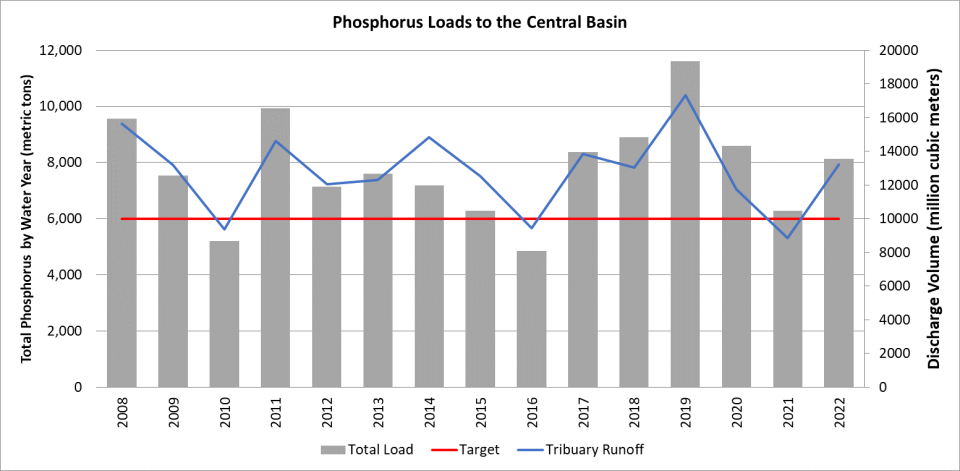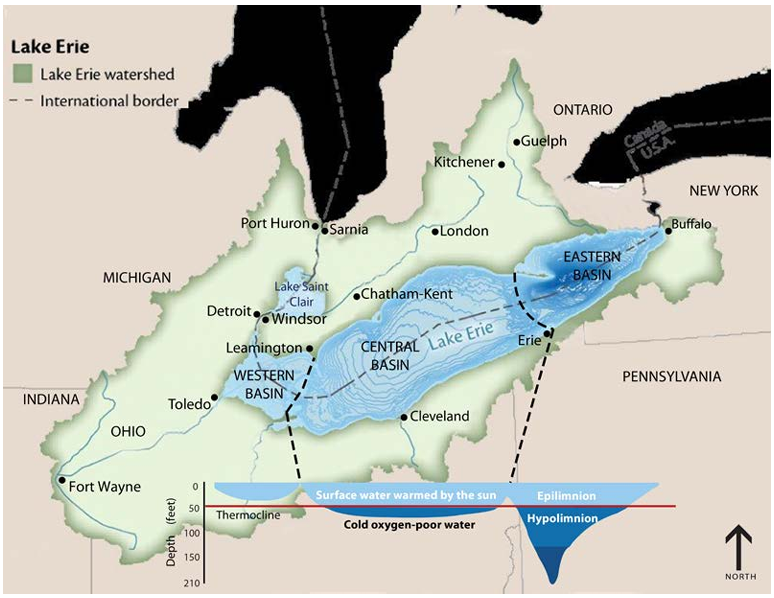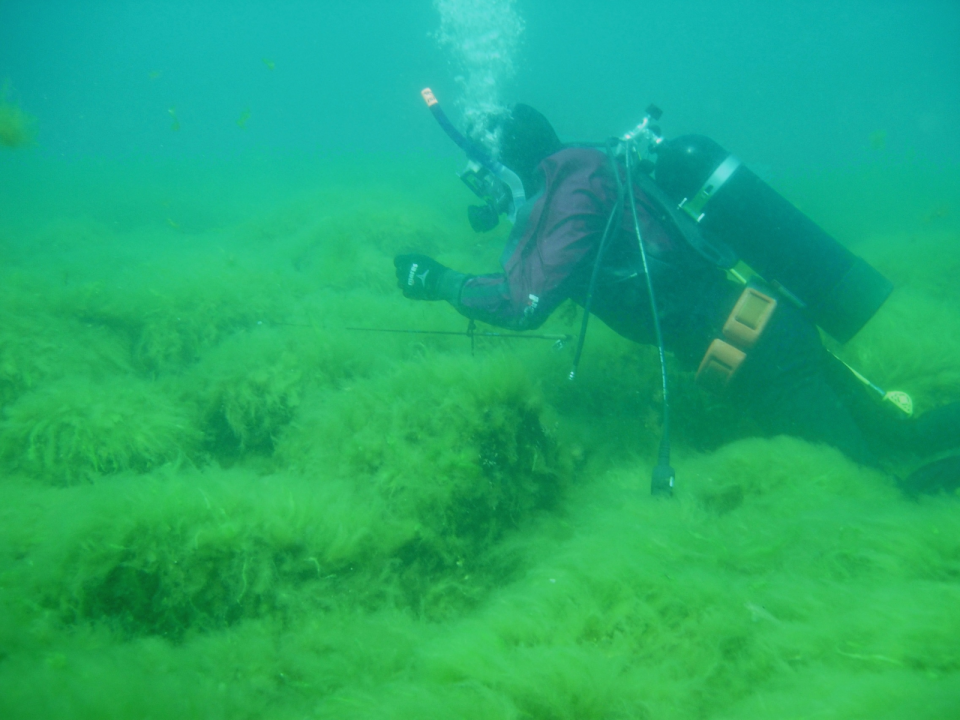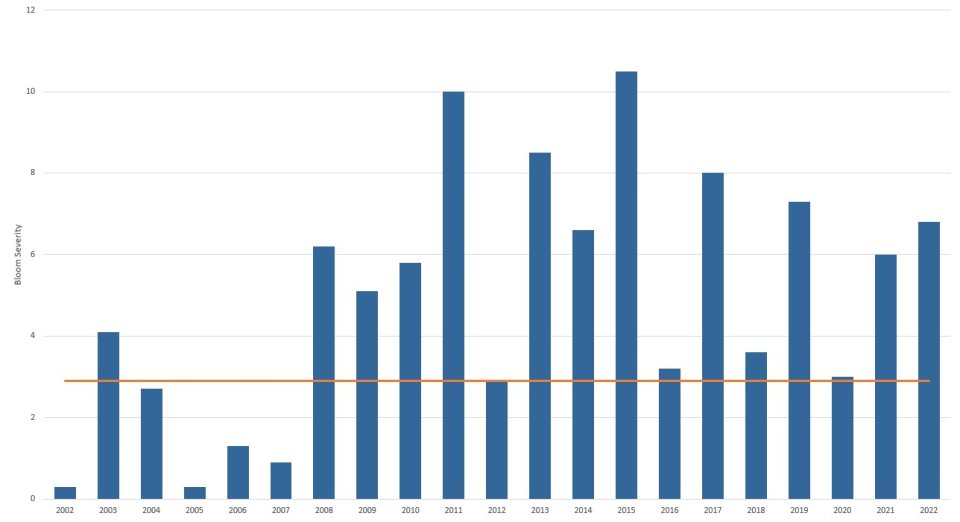Lake Erie Water Quality Data
On this page:
- Overall Conditions
- Phosphorus Loads
- Harmful Algal blooms
- Hypoxia
- Nuisance benthic algae
- Data and Reports
Overall Conditions
Phosphorus loads to Lake Erie and the in-lake response of harmful algal blooms and hypoxia are tracked annually, and evaluated every 5 years. According to the 2017-2021 assessment, Lake Erie continues to exhibit eutrophic or high nutrient conditions. Eutrophic conditions promote plant and algae growth. High phosphorus and chlorophyll concentrations and harmful algal blooms indicate that the western basin of Lake Erie is highly eutrophic. Phosphorus and chlorophyll concentrations in the central and eastern basins are relatively stable and consistent with the desired ranges. However, hypoxia remains a concern in the central basin and shoreline wash-up of nuisance benthic algae is an issue in the eastern basin.
As of 2021 , there is no evidence of a declining trend in phosphorus loads. Across the basin, annual changes in tributary loads correlate with changes in river discharge. The smallest loads occur in the driest years. The Maumee River is the key driver of the western basin HAB. When we remove the influence of flow and examine the results over the past ten years, total phosphorus concentrations are stable in the Maumee River watershed and dissolved reactive phosphorus may be declining.
Phosphorus Loads
EPA and ECCC work together to calculate Total Phosphorus (TP) loads to Lake Erie on an annual basis. The loads are calculated using available data and statistical models to estimate the phosphorus contribution from a variety of sources.
As of 2022, phosphorus load targets are mostly not being met and load reduction trends are difficult to discern. Phosphorus loads continue to be largely driven by tributary discharge volume, which is highly variable from year-to-year. The target of 6,000 metric tons annually (MTA) was only met once from 2013 - 2022 (in 2016, a notably dry year).
Table of Annual Phosphorus Loads from 2008 - 2022

U.S. Priority Tributaries
Ten U.S. tributaries were assigned a target to reduce total annual phosphorus and/or phosphorus during spring (defined as March through July).
Phosphorous in spring
Rain and snowmelt during the spring (March 1 through July 31) are a driver of bloom severity later in the summer. Progress is tracked by counting the number of years for which targets for soluble reactive phosphorus loads were met during the past ten years.
Status of the six U.S. priority watersheds assigned a target to reduce spring (March through July) dissolved phosphorus loads (2013 - 2022). Source: Great Lakes Commission, Blue Accounting
- 20% Maumee River (target met 1 of 10 years)
- N/A Toussaint River (target not yet established)
- 70% Portage River (target met 7 of 10 years)
- 10% Sandusky River (target met 1 of 10 years)
- N/A Huron River, OH (target not yet established)
- N/A River Raisin (target not yet established)
Phosphorus throughout the year
Limiting the annual total phosphorus load is thought to keep oxygen concentrations in the bottom waters of Lake Erie at an acceptable level to avoid hypoxia (these low-oxygen areas are sometimes referred to as "dead zones").
Status of the nine U.S. priority watersheds assigned a target to reduce total annual phosphorus (2013 - 2022). Source: Great Lakes Commission, Blue Accounting
- 40% Maumee River (target met 4 of 10 years)
- 30% Portage River (target met 3 of 10 years)
- 40% Sandusky River (target met 4 of 10 years)
- 30% Huron River, Ohio (target met 3 of 10 years)
- 80% Vermillion River (target met 8 of 10 years)
- 30% Cuyahoga River (target met 3 of 10 years)
- 40% Grand River (target met 4 of 10 years)
- 50% Detroit River (U.S. portion) (target met 5 of 10 years)
- 50% River Raisin (target met 5 of 10 years)
Harmful Algal Blooms
Blooms with the potential to harm human health or aquatic ecosystems are referred to as harmful algal blooms. In freshwater systems, cyanobacteria (or blue-green algae) are microorganisms that can produce HABs. The phosphorus reduction targets are expected to reduce the amount of cyanobacteria biomass in the lake to less than 9,600 metric tons (MT) in 9 years out of 10. This metric assumes that minimizing biomass reduces the potential for high toxin production.
Lake Erie Bloom Severity, 2002-2022
Cyanobacteria biomass is measured over the growing season using remote sensing validated with water samples taken in the field. The National Oceanic and Atmospheric Administration (NOAA) calculates the bloom severity index (SI) based on the maximum biomass over a 30-day window. The desired threshold of less than 9,600 MT biomass approximately corresponds to an SI of 2.9. An SI above 5 is considered a severe bloom, while blooms over 7 are very severe.
Overall, there is high interannual variability in the severity of the bloom. Between 2017 to 2021, the bloom SI target was not met in any year, though the 2020 bloom came close with a SI of 3. The largest blooms to date have occurred in 2011 with a severity index of 10, and 2015, at 10.5. In 2022, the severity index was 6.8, which NOAA considers “moderately severe.”
Hypoxia


The central basin of Lake Erie has an average depth of 18.3 meters (60 feet) and a maximum depth of 25 meters (82 feet). Excess phosphorus contributes to hypoxic (low-oxygen) conditions in the cold bottom layer of the lake (the hypolimnion) when algae die and decompose. This decomposition uses up the oxygen during the summer, leaving little to none for the aquatic community which suffocates or moves elsewhere, creating Lake Erie’s “Dead Zone.”
Concentrations of dissolved oxygen in the central basin of Lake Erie exhibit high interannual variability. The target threshold average August-September hypolimnetic dissolved oxygen concentration at or above 2 mg/L was met eight times between 2008-2021.
Nuisance Benthic Algae

Cladophora and benthic algae can grow to nuisance levels in Lake Erie’s eastern basin. Cladophora is a type of stringy (filamentous) algae that grows on hard surfaces underwater. Cladophora is a type of stringy algae that grows on rocks, wood, logs, and other hard surfaces underwater. Cladophora grows rapidly during the warm summer months, detaches, and becomes free-floating mats which can eventually become stranded on beaches.
USGS scientists are collaborating with other researchers to examine the influence of nutrient concentrations and invasive mussels on Cladophora growth. Field data collected by USGS scientists and divers is used to populate models that can help to develop Cladophora management strategies. This broad-scale, logistically complex effort is made possible with the help of multiple agency partners, including EPA, ECCC, and state agencies.

